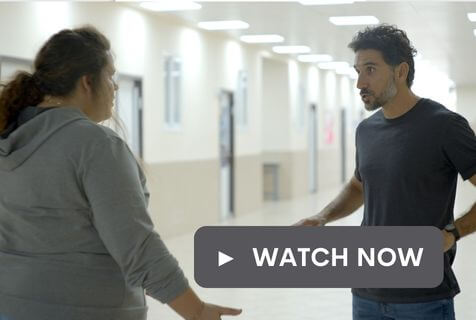Engaging Jewish Teenagers Isn’t Hopeless — If We Do It Right

Slow Dance: Teenagers dance at a prom in New Orleans in 2006 Image by Getty Images
(JTA) — Welcoming teens into Jewish life is both one of the most important and seemingly challenging endeavors of the Jewish community. The rapid decline in teen engagement in Jewish life post-b’nai mitzvah is well-documented and depressing. It’s also an entirely reversible trend, but only if the Jewish community approaches teen engagement in a new way — one that recognizes the whole teen and values her or him as an equal partner in creating experiences that add meaning to her or his life.
In general, Jewish teens (like non-Jewish peers) today are deeply thoughtful, inquisitive and ambitious. Also like their peers, they can be narcissistic and attached to technology. Most of today’s teens are vastly different than a generation ago, and in many ways different than a decade ago. These changes are due in large part to the changing world in which we live, the central role of technology and the nearly endless opportunities for personal customization a click away.
We know this because over the last 2 1/2 years, The Jewish Education Project led major research to learn about Jewish teens from Jewish teens. We heard directly from them about their lives, their views on spirituality, their ambitions, their fears, their feelings toward friends and family, how they form their identities and more. We’ve compiled and analyzed the findings into a new report, Generation Now: Understanding and Engaging Jewish Teens Today.
The report’s insights are a wake-up call to organizations or individuals who want to engage Jewish teens. Our community needs to work with teens to create experiences that address all aspects of their lives.
Just a few insights from Generation Now show the depth of Jewish teens today:
- Jewish teens want programs of substance that add value to some facet of their life. Teens are most likely to find Jewish knowledge meaningful when they see the connections and relevance to the rest of their lives. Programs that blend this value with opportunities to have fun, socialize and be with friends are especially attractive.
- While many teens still see Judaism as a religion, many more relate to being Jewish in language commonly associated with ethnicity, culture, heritage or tribal affiliation.
- Being a minority group in the U.S. is something that many Jewish teens highly value and feel pride in, but they do not view themselves as being special for this reason. In fact, many Jewish teens enjoy involving non-Jewish friends in “Jewish activities.”
- Jewish teens often are both universalists and particularists. Their orientation is fluid and depends on their environment. As an example, “doing good” is an important value, but seldom seen as a Jewish value.
- During major holidays, teens appreciate time to bond with immediate family, visit extended family and enjoy family traditions, particularly around “traditional” foods. Most of today’s teens enjoy spending time with their parents.
The challenge now is to take the report’s insights and have them inform our community’s approach to Jewish teen education and engagement. We must move beyond thinking about teens as passive recipients of Jewish learning experiences. Instead, we must begin designing initiatives and programs with Jewish teens, for Jewish teens.
Many teens are ready to lead now and want to have skin in the game. They are the most effective people to engage their peers. At the recent Summit on Jewish Teens, held during the BBYO International Convention in February, teens welcomed the invitation to take a place on the stage and at the table with philanthropists, lay leaders, professionals and others — to network with these individuals, to learn from one another, and to share and hear about the latest developments in Jewish teen engagement.
Every community is different, with differences within each community itself. A “cookie cutter” approach to programming would inevitably fail. Yet Generation Now offers recommendations for all communities to bear in mind. Effective initiatives will engage teens intellectually, physically and socially; will offer something that teens want to share with friends; will be demonstrably applicable to teens’ lives; will help to develop skills; will help teens feel proud of being Jewish; will help teens be better citizens of the world; and/or will help teens make the world a better place.
Changes in teen engagement will come from existing organizations that can adapt and do things differently, and from the creation of new organizations ready to engage 21st century Jewish teens.
Together with teens, we can make Jewish experiences a meaningful and central part of their lives.
David Bryfman, Ph.D., is the chief innovation officer at The Jewish Education Project, which is a beneficiary agency of UJA Federation of New York. Generation Now was commissioned by the Jim Joseph Foundation, Lippman Kanfer Foundation for Living Torah, the Charles and Lynn Schusterman Family Foundation and The Marcus Foundation.
A message from our Publisher & CEO Rachel Fishman Feddersen

I hope you appreciated this article. Before you go, I’d like to ask you to please support the Forward’s award-winning, nonprofit journalism so that we can be prepared for whatever news 2025 brings.
At a time when other newsrooms are closing or cutting back, the Forward has removed its paywall and invested additional resources to report on the ground from Israel and around the U.S. on the impact of the war, rising antisemitism and polarized discourse.
Readers like you make it all possible. Support our work by becoming a Forward Member and connect with our journalism and your community.
— Rachel Fishman Feddersen, Publisher and CEO




























